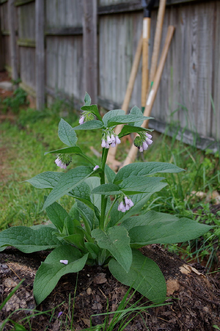In organic agriculture, as in ‘conventional’ farming, it is important to feed crops to ensure healthy and vigorous growth. As a general rule plants need three major nutrients: potassium (or potash, K+), nitrogen (N) and phosphorus (P). Each of these major components contributes to a different area of growth: potassium is needed for flower formation and to ripen fruit; nitrogen encourages healthy leaf growth and phosphorus aids root development. Plants also need a wide spectrum of other minerals and nutrients to grow.
There are numerous strategies for providing plant nutrition in an organic and sustainable manner, some of which are described below. Using a mixture of these methods will provide a balanced source of nourishment for crops and ensure that soil fertility does not decrease - you may find that your soil will improve, even with heavy cropping.
Mulch[]
Applying an organic mulch around crops or trees, using it as a groundcover or using it to staunch weed growth, can enrich the soil with nutrients as it slowly decomposes. However, not all plant material is suitable as a mulch as it may leach nitrogen from the soil as it decomposes. Some good short-term mulches are straw, leafmould and cardboard, all of which may be obtained cheaply or for free. Short-term mulches will rot away in a season or less and will need to be replaced frequently. Longer-lasting mulches, such as woodchip or bark, will provide slower benefits for a much longer period of time but will be less easy to plant into and cannot be dug into the ground as a short-term mulch can. A longer-lasting mulch may be more suitable for perennial plants.
Green Manure[]
A green manure is a plant grown on-site that is cut down and either composted or applied as-is, as a mulch. There are numerous advantages to using green manures over alternative mulches and, if you can spare the space, it is worth pursuing. Green manures are often more sustainable than bringing in mulches such as animal dung or straw as they require no transportation - this can also save a substantial amount of effort for those involved, even when simply moving mulch material around a single site. The ability to grow a mulch on the bed it will be used to cover, or close at hand, makes for a painless experience.
Comfrey[]

A perennial herb and a well-known dynamic accumulator. Comfrey (Symphytum spp.) has been traditionally used within conventional smallholding and permaculture systems as a green mulch, a ground cover crop and for making liquid fertilisers.
Comfrey contains minerals such as calcium and iron as well as potassium, nitrogen and phosphorus in large amounts. Due its large root system and taproot, comfrey is able to extract nutrients from deep within the soil and bring them up to the surface.
Comfrey also has a low carbon:nitrogen ratio (C:N) and so the soil will not be robbed of nitrogen when it decomposes, unlike some plant matter. This makes it an ideal enrichment for compost or chop-and-drop mulch (where cut leaves are left on the soil to decompose and provide nourishment, as well as blocking out competition).
“Bocking 14” is a sterile cultivar of Russian comfrey (Symphytum x uplandicum) and, thus, will not spread via seed. This can be advantageous as comfrey is difficult to remove once established and will spread easily.
Liquid Herbal Fertilisers[]
Also known as compost teas, liquid fertilisers can be easily made by filling a woven sack full of plant material and steeping it in a large volume of water for 3-5 weeks (or until it begins to really smell!). Typically a ratio of 10:1, water to plant material, is used - a black wheelie bin is a good volume for a woven refuse sack.
Compost teas can be applied to the soil or sprayed directly onto plants as a diluted foliar feed. Plants absorb nutrients readily through their leaves (some species, such as mosses, are rootless and entirely nonvascular and absorb all of their nutrients in this manner) and are often much more efficient at doing so than via their roots. Using a pressurised spray bottle is an easy way to apply a foliar feed.
Horsetail[]
Horsetail (Equisetum spp.) contains large amounts of silica and creates a tea that is good for strengthening plant cell walls. This provides general vigour and health for the plant as it is less vulnerable to attack by pests.
Comfrey[]
Comfrey contains very high levels of potassium and a good amount of nitrogen and phosphorus. Comfrey tea should be diluted 10:1 when applied as a foliar feed.
Nettle[]
Nettle (Urtica diotica) contains high levels of nitrogen as well as other minerals such as iron. A compost tea made of nettles can be applied to encourage leafy growth. Nettle tea does not need to be diluted when applied as a foliar feed.
Soil Enrichment[]
Adding enrichment to a soil can increase the availability of nutrients and is an easy way of giving crops a head start when planting. It is particularly worth adding some enrichment for larger, slower growing plants, such as trees. Some common soil enrichers, all of which contain a multitude of minerals and which can often be obtained for free, are ground bone meal, ground fish meal, dried seaweed and rock dust.
Biochar or perlite is also added as these substances are extremely porous and help to retain moisture and minerals within the soil around the plants’ root system, encouraging microbial growth and providing a reservoir during droughts.